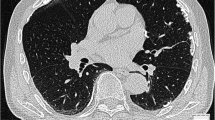Abstract
Six subjects with asbestos-related fibrosis of the pleura who complained of shortness of breath as the cause of limiting effort were studied by a progressive exercise test to clarify the underlying mechanism(s). Significant parenchymal disease was excluded by gallium scan and computed tomography. All subjects showed limitation of maximum exercise capacity; 5 also showed increases in minute ventilation, frequency of breathing and inspiratory flow rates, decreases in tidal volume, and elevated dead space/tidal volume ratios during submaximal exercise. Fatigue of the diaphragm on exercise assessed by electromyographic techniques in 3 subjects was not a limiting factor, and the perception of shortness of breath on effort appears to have been attributable to the abnormal breathing pattern adopted. This, in turn, could be accounted for by increases in chest wall impedance due to reduced compliance of the parietal pleura.
Similar content being viewed by others
References
Apps MCP, Britton MG, Maxwell DL, Hughes DTD, Hanson A (1983) Breathlessness and hyponia on exercise in patients with asbestos related disease. Am Rev Respir Dis 127 (part 2): 180
Becklake MR (1982) Asbestos-related diseases of the lungs and pleura: current clinical issues. Am Rev Respir Dis 126:187–194
Becklake MR, Fournier-Massey G, McDonald JC, Siemiatycki J, Rossiter CE (1970) Lung function relation to chest radiographic changes in Quebec asbestos workers. Bull Physiopathol Respir 6:637–659
Bellemare F, Grassino A (1982) Effect of pressure and timing of contraction on human diaphragm fatigue. J Appl Physiol 53:1190–1195
Bellemare F, Grassino A (1982) Evaluation of human diaphragm fatigue. J Appl Physiol 53:1196–1206
Bland S, Lazaron L, Dyck G, Cherniack RM (1967) The influence of the chest wall on respiratory rate and depth. Respir Physiol 3:47–54
Britton MG (1980) Asbestos pleural disease: a case for compensation. Thorax 35:714
Britton MG (1982) Asbestos pleural disease. Br J Dis Chest 76:1–10
Burdon JGW, Killian KJ, Jones NL (1983) Pattern of breathing during exercise in patients with interstitial lung disease. Thorax 778–784
Cherniack RM, Raber MB (1972) Normal standards for ventilatory function using an automated wedge spirometer. Am Rev Respir Dis 106:36–46
Cotes JE (1979) Lung function: assessment and application in medicine, 4th ed. Blackwell Scientific Publications, Oxford pp 329–387
Craighead JE, Abraham JL, Churg A, Green FHY, Kleinerman J, Pratt PC, Seemayer TA, Vallyathan V, Weill H (1982) Asbestos-related diseases. Arch Pathol Lab Med 106:544–596
Epler GR, McLoud TC, Gainsler EA, Mikus JP, Carrington CB (1978) Normal chest roentgenorgams in chronic diffuse infiltrative disease. N Engl J Med 298:934–939
Gold WM, Nadel J (1966) Dyspnea and hyperventilation associated with unilateral disease of the chest wall relieved by blocking the intercostal nerves. In: Howell JBL, Campbell EJM (eds) Breathlessness. Blackwell Scientific Publications, Oxford, pp 223–227
Goldman HI, Becklake MR (1959) Respiratory function tests: normal values at median altitudes and the prediction of normal results. Am Rev Tubercul 79:457–467
Grimby G, Goldman M, Mead J (1976) Respiratory muscle action inferred from rib cage and abdominal V-P partitioning. J Appl Physiol 41:739–751
Gross D, Grassino A, Tsanaclis A, Roussos C, Macklem PT (1979) Electromyogram pattern of diaphragmatic fatigue. J Appl Physiol 46:1–7
Hourihane DO’B, Lessof L, Richardson PC (1966) Hyaline and calcified pleural plaques as an index of exposure to asbestos: a study of radiological and pathological features of 100 cases with a consideration of epidemiology. Br Med J 1:1069–1074
ILO/UC International Classification of Radiographs of Pneumoconiosis. Occupational Safety and Health Series No. 22 (Rev.) 1980, Geneva, ILO.
Jones NL, Campbell EJM (1982) Clinical exercise testing, 2nd ed. WB Saunders, Philadelphia, pp 1–268
Killian KJ, Bucens DD, Campbell EJM (1982) Effect of breathing patterns on the perceived magnitude of added loads of breathing. J Appl Physiol 52:578–584
Kreel L (1976) Computer tomography evaluation of pulmonary asbestosis. Acta Radiol Diagn 17:405–412
Lumley KPS. Physiological changes in asbestos pleural disease. In: Walton WH (ed) Inhaled Particles. N. Oxford.
McMillan GHG, Rossiter CE (1982) Development of radiological and clinical evidence of parenchymal fibrosis in men with nonmalignant asbestos-related pleural lesions. Br J Ind Med 39:54–59
Morgan WKC (1982) Pulmonary disability and impairment. Can’t work? Won’t work? Am Thorac Soc News 8:30–35
Morris JF, Koski A, Johnson LC (1971) Spirometric standards for healthy non-smoking adults. Am Rev Respir Dis 103:57–67
Parkes WR (1982) Occupational lung disorders, 2nd ed. Butterworths, London, p 244
Pope H, Holloway R, Campbell EJM (1968) The effects of elastic and resistive loading of inspiration on the breathing of conscious men. Respir Physiol 4:363–372
Sheers G (1979) Asbestos associated disease in employees of Devonport dockyard. Ann NY Acad Sci 330:295–312
Wright PH, Hanson A, Kreel L, Capal LH (1980) Respiratory function changes after asbestos pleurisy. Thorax 35:31–36
Author information
Authors and Affiliations
Rights and permissions
About this article
Cite this article
Picado, C., Laporta, D., Grassino, A. et al. Mechanisms affecting exercise performance in subjects with asbestos-related pleural fibrosis. Lung 165, 45–57 (1987). https://doi.org/10.1007/BF02714420
Accepted:
Issue Date:
DOI: https://doi.org/10.1007/BF02714420




